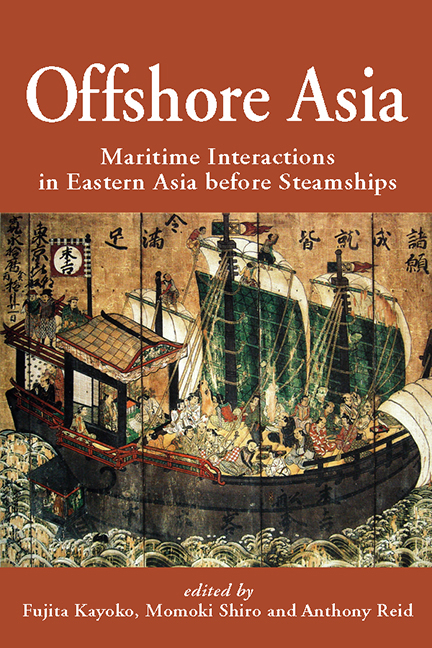Book contents
- Frontmatter
- Contents
- Maps
- Tables and Figures
- Preface
- Contributors
- Map 1 Eastern Asia in the 13th–16th Centuries
- 1 Introduction: Maritime Interactions in Eastern Asia
- 2 The Periodization of Southeast Asian History, in Comparison with that of Northeast Asia
- 3 Merchants, Envoys, Brokers and Pirates: Hokkien Connections in Pre-modern Maritime Asia
- 4 An Asian Commercial Ecumene, 900–1300 ce
- 5 The Japanese Archipelago and Maritime Asia from the 9th to the 14th Centuries
- 6 Saltpetre Trade and Warfare in Early Modern Asia
- 7 Shaping Maritime East Asia in the 15th and 16th Centuries through Choson Korea
- 8 Shipwreck Salvage and Survivors’ Repatriation Networks of the East Asian Rim in the Qing Dynasty
- 9 Wei Zhiyan and the Subversion of the Sakoku
- 10 Metal Exports and Textile Imports of Tokugawa Japan in the 17th Century: The South Asian Connection
- Bibliography of Works Cited
- Index
- NALANDA-SRIWIJAYA SERIES
9 - Wei Zhiyan and the Subversion of the Sakoku
Published online by Cambridge University Press: 21 October 2015
- Frontmatter
- Contents
- Maps
- Tables and Figures
- Preface
- Contributors
- Map 1 Eastern Asia in the 13th–16th Centuries
- 1 Introduction: Maritime Interactions in Eastern Asia
- 2 The Periodization of Southeast Asian History, in Comparison with that of Northeast Asia
- 3 Merchants, Envoys, Brokers and Pirates: Hokkien Connections in Pre-modern Maritime Asia
- 4 An Asian Commercial Ecumene, 900–1300 ce
- 5 The Japanese Archipelago and Maritime Asia from the 9th to the 14th Centuries
- 6 Saltpetre Trade and Warfare in Early Modern Asia
- 7 Shaping Maritime East Asia in the 15th and 16th Centuries through Choson Korea
- 8 Shipwreck Salvage and Survivors’ Repatriation Networks of the East Asian Rim in the Qing Dynasty
- 9 Wei Zhiyan and the Subversion of the Sakoku
- 10 Metal Exports and Textile Imports of Tokugawa Japan in the 17th Century: The South Asian Connection
- Bibliography of Works Cited
- Index
- NALANDA-SRIWIJAYA SERIES
Summary
Studies of the Chinese junk trade with Tokugawa Japan under the so-called sakoku policy fall, in general, into two categories — namely studies of institutions and studies of quantities. The first has focused on administrative institutions, regulations and procedures the Tokugawa authorities installed one after another over years. The latter has made great and almost heroic efforts to quantify imports and exports carried by Chinese junks as opposed to those by the Dutch ships. Yet, such approaches inherently conceal and gloss over more “human” aspects of trade. This is to say, individual traders and their networks among the local community have never been studied in any real depth.
This chapter first lays out the regulatory frameworks placed upon Chinese people and their trading activities while they were on Japanese soil, by examining a series of edicts the Tokugawa bakufu issued during the 1630s. The second part introduces Wei Zhiyan, a Chinese merchant who, despite all the official rules and regulations, resided in Nagasaki from the 1650s and concurrently carried on foreign trade until the early 1680s. Previous studies, which did not acknowledge the existence of such a Chinese trading operation originating from Nagasaki after the 1630s, were not able to explain how Wei manoeuvred around the restrictive Japanese government policies and pursued his commercial ventures. In search of clues to answer this question, the last part of this essay explores Wei's personal ties with the Nagasaki local community.
THE SAKOKU EDICTS AND CHINESE RESIDENTS IN JAPAN: IN THEORY
Towards the end of the 16th century, thriving trade between China and Japan created the conditions whereby Chinese residents could be seen everywhere in Japan. Chinese junks were allowed to call at any port, and people of Chinese origin were free to settle anywhere in Japan or to leave there again for another overseas venture.1 However, during the 1630s, the Tokugawa bakufu successively issued five directives to the magistrates of Nagasaki. The so-called sakoku edicts gradually changed the landscape of maritime East and Southeast Asia, including the position of Chinese junks and residents in Japan. The following section will outline the contents of the edicts concerning Chinese activities at Nagasaki and their effects.
- Type
- Chapter
- Information
- Offshore AsiaMaritime Interactions in Eastern Asia before Steamships, pp. 236 - 258Publisher: ISEAS–Yusof Ishak InstitutePrint publication year: 2013

